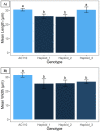First Gynogenesis of Vanilla planifolia for Haploid Production and Ploidy Verification Protocol
- PMID: 38999575
- PMCID: PMC11243312
- DOI: 10.3390/plants13131733
First Gynogenesis of Vanilla planifolia for Haploid Production and Ploidy Verification Protocol
Abstract
Vanilla orchids are members of the Vanilloideae orchid subfamily, and they hold significant economic value as a spice crop in tropical regions. Despite the presence of 180 known species within this subfamily, commercial production focuses on only three species (Vanilla planifolia, V. odorata, and V. pompona) and one hybrid (V. × tahitensis), prized for their aromatic qualities and bioactive compounds. Limited modern breeding initiatives have been undertaken with vanilla orchids, although recent advancements in genomic research are shedding light on this crop's potential. The protracted breeding cycle of vanilla, coupled with increasing demand for germplasm, underscores the importance of research and breeding efforts in vanilla. This paper outlines a protocol for haploid production in V. planifolia using unfertilized ovaries in tissue culture conditions. Additionally, we present a methodology to confirm the haploid nature of putative haploid lines through stomatal size comparison, chromosome counting, and flow cytometry analysis, proving the successful development of haploid vanilla plants. These findings contribute to the advancement of breeding programs and genetic improvement strategies for the vanilla industry.
Keywords: Vanilla planifolia; gynogenesis; haploids; ploidy; tissue culture.
Conflict of interest statement
The authors declare no conflicts of interest.
Figures









References
-
- Menz K.M., Fleming E.M. ACIAR Technical Reports. Australian Centre for International Agricultural Research; Canberra, Australia: 1989. Economic Prospects for Vanilla in the South Pacific.
-
- Erawati D.N., Wardati I., Humaida S., Fisdiana U. Micropropagation of Vanilla (Vanilla planifolia Andrews) with Modification of Cytokinins. IOP Conf. Ser. Earth Environ. Sci. 2020;411:012009. doi: 10.1088/1755-1315/411/1/012009. - DOI
-
- Chambers A., Cibrián-Jaramillo A., Karremans A.P., Martinez D.M., Hernandez-Hernandez J., Brym M., Resende M.F., Moloney R., Sierra S.N., Hasing T., et al. Genotyping-By-Sequencing diversity analysis of international Vanilla collections uncovers hidden diversity and enables plant improvement. Plant Sci. 2021;311:111019. doi: 10.1016/j.plantsci.2021.111019. - DOI - PubMed
-
- Koyyappurath S., Atuahiva T., Le Guen R., Batina H., Le Squin S., Gautheron N., Hermann V.E., Peribe J., Jahiel M., Steinberg C., et al. Fusarium oxysporum f. sp. radicis-vanillae is the causal agent of root and stem rot of vanilla. Plant Pathol. 2015;65:612–625. doi: 10.1111/ppa.12445. - DOI
-
- Ramos-Castellá A., Iglesias-Andreu L.G., Bello-Bello J., Lee-Espinosa H. Improved propagation of vanilla (Vanilla planifolia Jacks. ex Andrews) using a temporary immersion system. Vitr. Cell. Dev. Biol.-Plant. 2014;50:576–581. doi: 10.1007/s11627-014-9602-8. - DOI
Grants and funding
LinkOut - more resources
Full Text Sources

